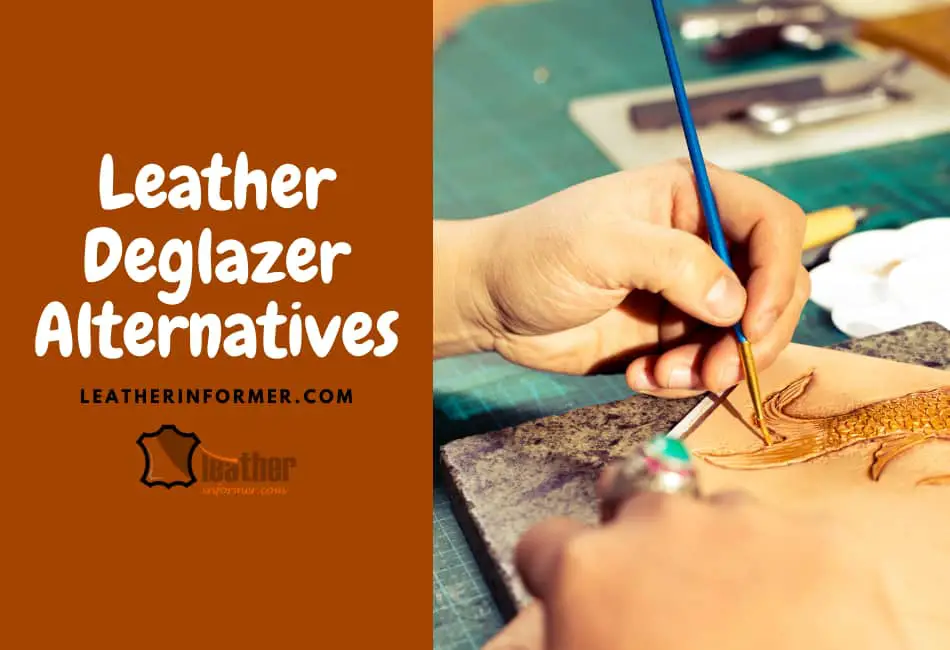I have a cute little purse I tried being creative with by painting a beautiful floral and fish design on. Unfortunately, after the paint had dried, I realized it was not adhering to the leather very well and started to peel off.
I investigated why this happened and found out the leather surface was not toothed. The nature of the leather surface meant paint could not permanently adhere to its surface.
Upon researching, I found two ways around this issue:
- Use some kind of solution to etch or tooth the leather so the paint can have something to grab on to,
Or
- Use a surface primer designed for leather – which according to some sources, could still lead to the paint peeling or poor dye penetration if you’re dying the leather.
I decided to try the first method of degreasing or deglazing the leather surface. The best way to do this is to actually use a leather deglazer which you can buy at leathercraft stores and most online stores like Amazon.
But since I’m all about DIYs and natural solutions, and I had nothing to lose, I decided to try a few household alternatives first.
After doing some testing, I’ve compiled a list of the best ones below. Hopefully, this will save you the time and money of having to test them all out as I did! But before we get into that, let’s first talk about what a leather deglazer actually is and does.
What Is A Deglazer?
A leather deglazer is a solvent that removes any kind of surface buildup like patina, grease, dirt, and stains in preparation for activities like dyeing, painting, or simply to clean the leather.
Leather deglazers are sometimes also known as leather strippers and leather degreasers. They come mainly in liquid forms and contain ingredients that help break down or emulsify tough stains and dirt so they can be easily wiped away.
The main goal of using a leather deglazer is to ensure that the leather surface is clean enough for the new finish or product to adhere well.
Now that we have a good understanding of what a leather deglazer is and does let’s get into the good stuff – the deglazer alternatives!
Best Leather Deglazer Alternatives
Here are 11 leather deglazer alternatives that can be found in most households:
1. Vinegar
Yes, that common kitchen ingredient can also be used as a deglazer! Vinegar is acidic and will eat away at any dirt, grease, or grime on the surface of your leather.
Not only that, but vinegar is also a natural disinfectant, so it will kill any bacteria that might be lurking on your leather. So vinegar will do the trick, whether it is just a quick cleaning you need or some serious degreasing.
Just be sure to use white vinegar, not apple cider vinegar or any other kind, as those can darken leather. To deglaze with vinegar;
Step One:
- Simply mix equal parts of water and white vinegar in a bowl.
Step Two:
- Dip a clean cloth into the mixture and wring it out, so it’s damp but not dripping wet.
Step Three:
- Rub the cloth over the entire leather surface in small circular motions.
- If you’re dealing with a leather surface that needs serious deglazing, you can leave the vinegar mixture on for a few minutes before wiping it off.
- Just be sure to do a patch test on a small inconspicuous area of the leather first to ensure the vinegar doesn’t damage or change the color of your leather.
Step Four:
- Once you’re done, rinse the area with clean water and dry it off with a soft cloth.
Step Five:
- Make sure to follow up with a leather conditioner to help restore all the essential oils once you’re done painting or dyeing the leather.
2. Rubbing Alcohol
Another awesome leather deglazer alternative that was so effective was rubbing alcohol. In fact, rubbing alcohol was one of the deglazer alternatives that came to mind first since it is such a powerful cleaning agent.
And I was right, rubbing alcohol does an amazing job of degreasing and stripping leather surfaces. It will quickly remove any dirt, grease, or grime without damaging the leather.
The thing distinguishing the rubbing alcohol and, for example, vinegar was how quickly it dried.
After applying rubbing alcohol to a leather surface, it will evaporate and dry within minutes. This is important if you’re in a hurry and need to deglaze your leather quickly. To use rubbing alcohol as a deglazer, here’s the process I find works very much:
Step One:
- Start by pouring some rubbing alcohol into a clean and empty spray bottle.
- You want the rubbing alcohol to be 70% or higher for it to work effectively.
Step Two:
- Then, take a clean, soft microfiber cloth and lightly dampen it with rubbing alcohol.
Step Three:
- Next, start wiping down the leather surface in small circular motions.
- You’ll notice the dirt, grime, and grease coming off immediately.
Step Four:
- Once you’ve covered the entire surface, take another clean and dry microfiber cloth and wipe off any excess rubbing alcohol.
- And that’s it! Your leather should now be clean, degreased, and ready for painting or dyeing work.
The only thing to remember is that rubbing alcohol is a strong cleaning agent. So, if you’re using it on a very delicate or old leather surface, test it in an inconspicuous area first.
Also, make sure to use a good leather conditioner after you’re done dyeing, painting, or whatever the reason was you needed to deglaze your leather in the first place.
Leather conditioner will help replenish any natural oils that might have been stripped away during the deglazing process.
Other than that, rubbing alcohol is definitely one of the best leather deglazers alternatives out there and works like a charm!
Now, let’s move on to the next deglazer alternative, which is…
3. Hairspray
I must say this method surprised me the most because I would’ve never thought of using hairspray as a deglazer for leather.
But it turns out that hairspray is actually a really effective way to deglaze and cleanse a leather surface.
It works so well because most hairsprays contain alcohol, which we know from the previous method is a very powerful cleaning and degreasing agent for leather.
So, hairspray is a viable option if you’re in a pinch and need to deglaze your leather quickly. Here’s how to do it:
Step One:
- Start by testing the type or brand of hairspray you have on a small inconspicuous area of the leather.
- This is to make sure that the hairspray doesn’t damage or discolor your leather in any way.
Step Two:
- If the test goes well and there’s no adverse reaction, proceed by spraying a generous amount of hairspray onto the leather surface.
Step Three:
- Then, quickly take a clean and soft microfiber cloth and start wiping down the leather in small circular motions.
- You should see the dirt, grease, and grime coming off immediately.
Step Four:
- Once you’ve deglazed the entire surface, take another clean and dry microfiber cloth and wipe off any excess hairspray. And that’s it! Your leather should now be clean and ready for whatever you need to do with it.
Like with the rubbing alcohol method, remember that hairspray is a very powerful cleaning agent. So, test it in an inconspicuous area first.
Ensure that you use a good leather conditioner after you’re done to help replenish any natural oils that might have been stripped away during the deglazing process.
4. Baby Wipes
I figured this would work when the thought first popped into my head, and I’m happy to report that it does work!
Baby wipes are a really effective way to deglaze and cleanse a leather surface, especially if the leather surface does not need serious degreasing.
This method is perfect for those quick and light cleanings where you just need to remove some dirt, grime, or fingerprints from the leather. Here’s how to do it:
Step One:
- Start by taking a baby wipe and gently rubbing it over the soiled or dirty areas of the leather.
Step Two:
- Use a second baby wipe to go over the area you just cleaned with the first one.
Step Three:
If there are any stubborn areas of dirt or grime, use a cotton swab dipped in some distilled water to spot and clean those areas. And that’s it! Your leather surface should now be clean and free of any dirt or grime.
5. Mr. Clean Magic Erasers
Suppose you’re looking for a chemical-free or alcohol-free approach to deglazing your leather surface for painting, dyeing, or cleaning purposes. In that case, the Mr. Clean Magic Erasers are a great option to consider.
These things are amazing and can pretty much clean anything. It is made up of micro-abrasive foam that’s designed to lift away dirt and grime with just water.
With this, it means that you will essentially degrease your leather surface without using any harsh chemicals or solvents. Here’s how to do it:
Step One:
- Start wetting the Mr. Clean Magic Eraser with clean water until it’s nice and saturated.
- Now wring out the eraser until it is thoroughly damp and not dripping wet.
Step Two:
- Then, gently rub the leather surface in a simple back and forth motion.
- Rinse the magic eraser from time to time as you go along to avoid depositing too much dirt and grime back onto the leather.
Step Three:
- Once you’re done, take a clean microfiber cloth and wipe off any excess water from the leather surface. Allow it to air dry completely before proceeding to the next step.
- Your leather should now be clean and ready for your dyeing or painting project.
While the magic eraser works well, you will have to purchase a new one for each cleaning session.
And because it’s quite abrasive, there’s a chance that you might damage the leather if you’re not careful. So, use this method with caution.
6. Hand Sanitizer
Last but definitely not least, you can also deglaze your leather surface using hand sanitizer for the most obvious reason because it contains alcohol.
Alcohol is a very effective degreaser and will quickly remove any dirt, grime, or grease from the leather surface.
The only downside to using hand sanitizer is that it can be quite drying to the leather. So, make sure to use a good leather conditioner after you’re done deglazing your leather with this method. Here’s how to do it:
Step One:
- Start by applying a generous amount of hand sanitizer onto the leather surface.
Step Two:
Use a clean microfiber cloth or paper towel to wipe away the hand sanitizer along with the dirt, grime, and grease.
Step Three:
Once you’re done, take another clean microfiber cloth and wipe off any excess hand sanitizer from the leather surface. Then, allow it to air dry completely.
Final Words
As you can see, there are quite a few ways to deglaze your leather surface without purchasing an actual leather deglazer.
Each of these methods works, but their effectiveness will depend on the severity of the dirt and grime build-up on your leather surface.
So, start with the gentler methods first and then move on to the more abrasive ones if needed. Do you have any other methods that you use to deglaze your leather surface? Let me know in the comments below! Thanks for reading!

